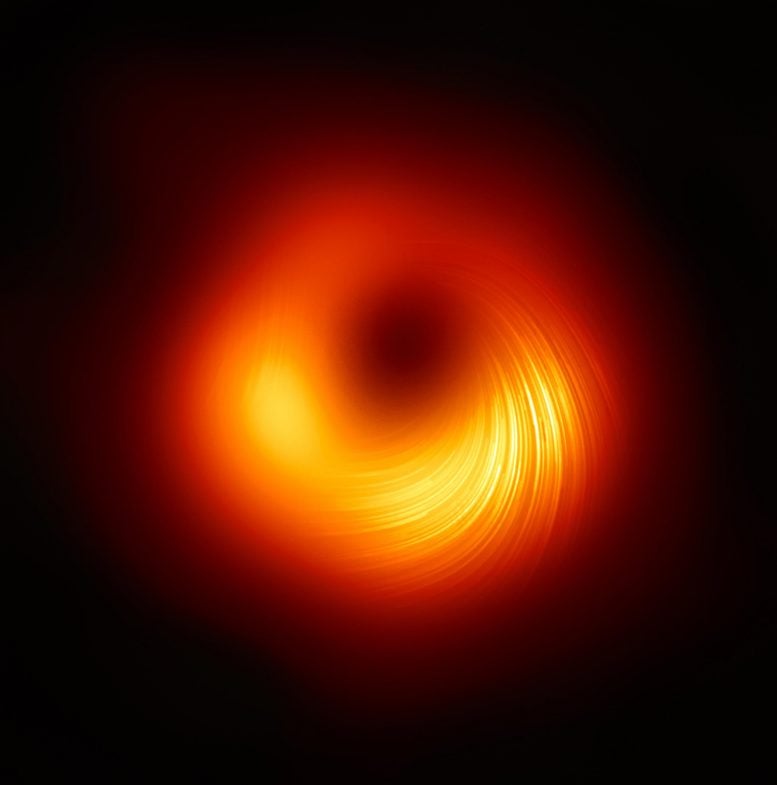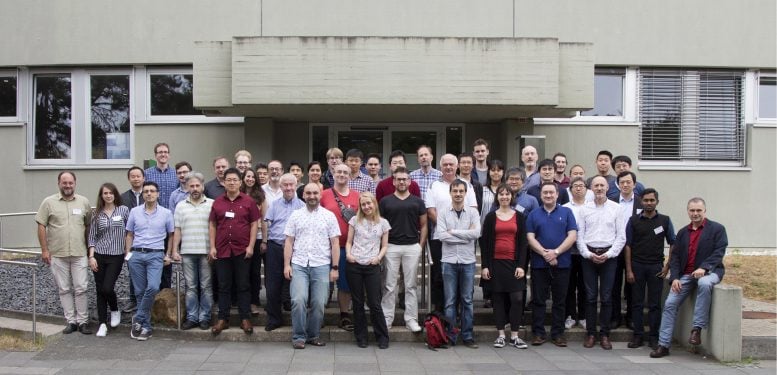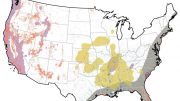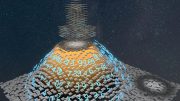
Polarized view of the black hole in M87. The lines mark the orientation of polarization, which is related to the magnetic field around the shadow of the black hole. Credit: EHT Collaboration
Wits University astrophysicists are the only two scientists on African continent that contributed to the study.
The Event Horizon Telescope (EHT) collaboration, a multinational team of over 300 scientists including two astrophysicists from the University of the Witwatersrand (Wits University), has revealed a new view of the massive object at the center of the M87 galaxy: how it looks in polarized light.
This is the first time astronomers have been able to measure polarization, a signature of magnetic fields, this close to the edge of a black hole. The observations are key to explaining how the M87 galaxy, located 55 million light-years away, is able to launch energetic jets from its core.
“We are now seeing the next crucial piece of evidence to understand how magnetic fields behave around black holes, and how activity in this very compact region of space can drive powerful jets that extend far beyond the galaxy,” says Monika Moscibrodzka, Coordinator of the EHT Polarimetry Working Group and Assistant Professor at Radboud Universiteit in the Netherlands.
“This work is a major milestone: the polarization of light carries information that allows us to better understand the physics behind the image we saw in April 2019, which was not possible before,” explains Iván Martí-Vidal, also Coordinator of the EHT Polarimetry Working Group and GenT Distinguished Researcher at the Universitat de València, Spain. He adds that “unveiling this new polarized-light image required years of work due to the complex techniques involved in obtaining and analyzing the data.”
Professor Roger Deane, SARAO/NRF Chair in Radio Astronomy at Wits and his postdoctoral researcher, Dr. Iniyan Natarajan, are the only two scientists in the EHT collaboration that are based on the African continent. On April 10, 2019, the collaboration released the first ever image of a black hole, revealing a bright ring-like structure with a dark central region — the black hole’s shadow. Today’s results reveal that a significant fraction of the light around the M87 black hole is polarized.
“When unpolarized, the oscillations of the electromagnetic fields have no preferred direction. Filters such as polarized sunglasses or magnetic fields in space, preferentially let the oscillations in one direction pass through, thereby polarizing the light. Thus, the polarized-light image illuminates the structure of the magnetic fields at the edge of the black hole,” says Natarajan, who was part of the EHT Polarimetry Working Group.
Black holes have long been known to launch powerful jets of energy and matter far out into space. Astronomers have relied on different physical models of how matter behaves near the black hole to better understand this process. The jet emerging from M87’s core extends at least 5000 light-years from its center, the process behind which is still unexplained.
The observations suggest that the magnetic fields at the black hole’s edge are strong enough to push back on the hot gas and help it resist gravity’s pull. Only the gas that slips through the field can spiral inwards to the event horizon.

Group picture of the workshop which triggered the imaging the magnetic fields at the Max-Planck-Institut für Radioastronomie in Bonn, Germany, on July 15-19, 2019. Credit: © E. Traianou/MPIfR
To observe the heart of the M87 galaxy, the collaboration linked eight telescopes around the world to create a virtual Earth-sized telescope, the EHT. The impressive resolution obtained with the EHT is equivalent to that needed to measure the size of a cricket ball on the surface of the Moon.
This setup allowed the team to directly observe the black hole shadow and the ring of light around it, with the new polarized-light image clearly showing that the ring is magnetized. The results are published today in two separate papers in The Astrophysical Journal Letters by the EHT collaboration.
“Peering as close as we can to the edge of black holes using cutting-edge techniques is precisely the sort of challenge we relish here at Wits,” says Deane, Founding Director of the newly approved Wits Center for Astrophysics. “We are in a golden era for radio astronomy, and our involvement in projects like the Event Horizon Telescope and the Square Kilometer Array is at the center of our plan to carry out fundamental research, and train world-class postgraduate students who will become the leading African scientists of tomorrow.”
Natarajan was involved in simulating the black hole polarization observations and was also part of the efforts to calibrate and generate the polarized image. Deane and Natarajan have also written one of the software packages that is being used to simulate black hole observations within the EHT collaboration.
“Our collaboration developed new techniques for analyzing the polarization data, which were validated on simulations before being applied to real observations,” says Natarajan.
“Such challenging projects provide the opportunity to develop techniques which later find wider applicability in the community in ways which can pleasantly surprise us.”
More on this research:
References:
“First M87 Event Horizon Telescope Results. VII. Polarization of the Ring” by The Event Horizon Telescope Collaboration, Kazunori Akiyama, Juan Carlos Algaba, Antxon Alberdi, Walter Alef, Richard Anantua, Keiichi Asada, Rebecca Azulay, Anne-Kathrin Baczko, David Ball, et al., 24 March 2021, Astrophysical Journal Letters.
DOI: 10.3847/2041-8213/abe71d
“First M87 Event Horizon Telescope Results. VIII. Magnetic Field Structure near The Event Horizon” by The Event Horizon Telescope Collaboration, Kazunori Akiyama, Juan Carlos Algaba, Antxon Alberdi, Walter Alef, Richard Anantua, Keiichi Asada, Rebecca Azulay, Anne-Kathrin Baczko, David Ball, et al., 24 March 2021, Astrophysical Journal Letters.
DOI: 10.3847/2041-8213/abe4de
“Polarimetric Properties of Event Horizon Telescope Targets from ALMA” by Ciriaco Goddi, Iván Martí-Vidal, Hugo Messias, Geoffrey C. Bower, Avery E. Broderick, Jason Dexter, Daniel P. Marrone, Monika Moscibrodzka, Hiroshi Nagai, Juan Carlos Algaba, et al., 24 March 2021, Astrophysical Journal Letters.
DOI: 10.3847/2041-8213/abee6a









… this should be a key for a gravitons do they exist or not.
In another worlds, this should be enough to kill graivitons or curved space time…